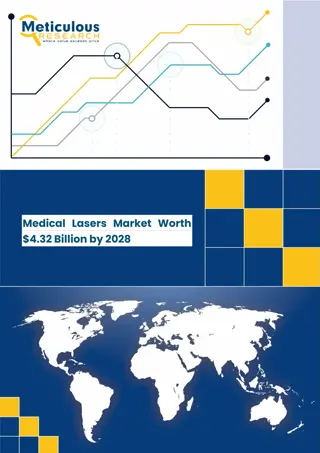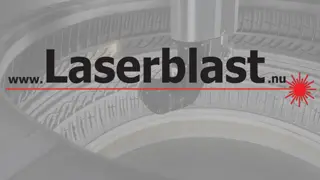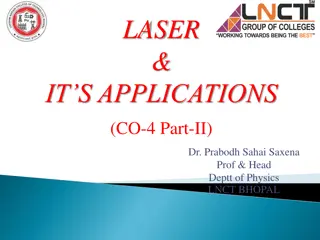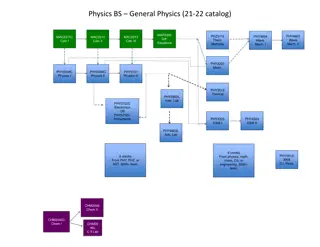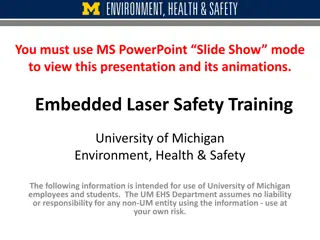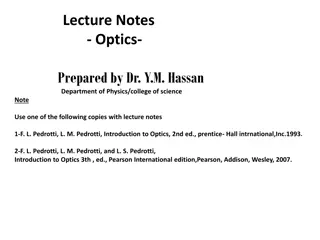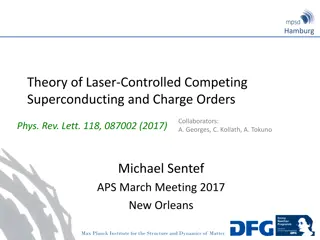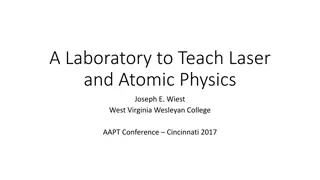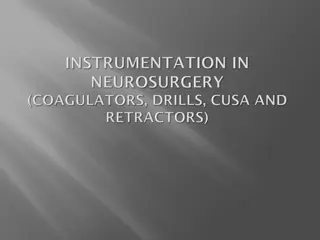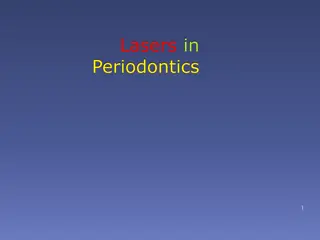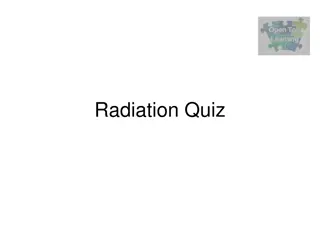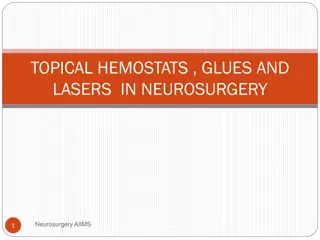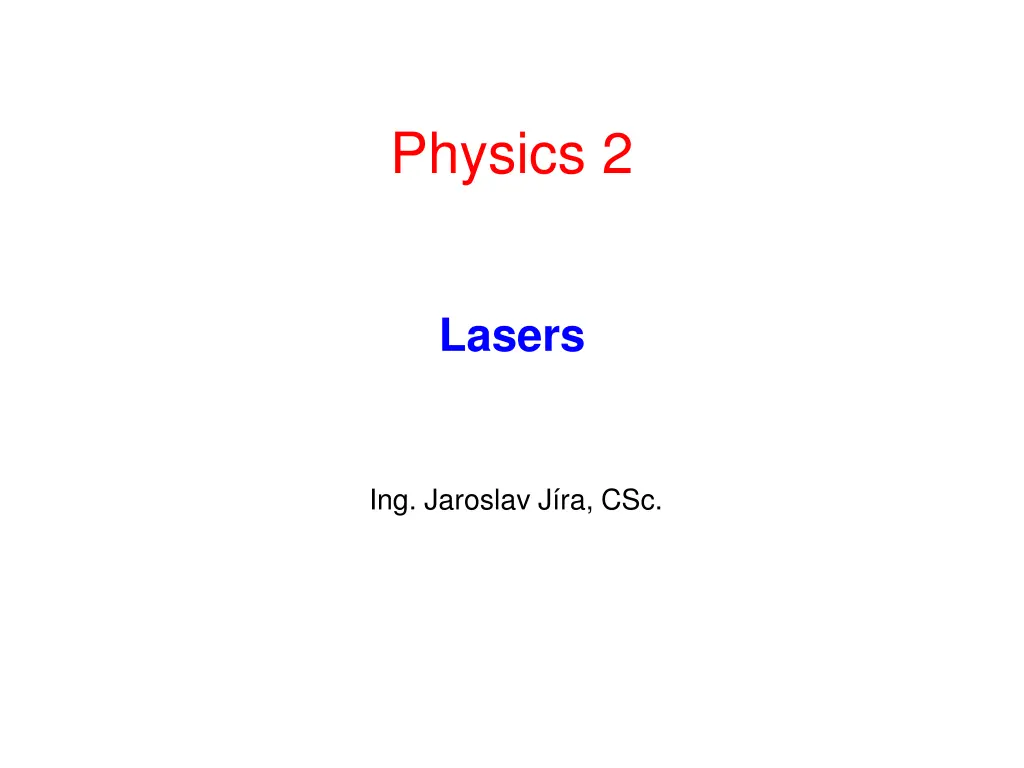
Understanding the Basics of Lasers and Population Inversion
Learn about the fundamentals of lasers, including the processes of absorption, spontaneous emission, and stimulated emission. Discover how population inversion is essential for laser operation and delve into the specifics of the Helium-Neon gas laser.
Download Presentation

Please find below an Image/Link to download the presentation.
The content on the website is provided AS IS for your information and personal use only. It may not be sold, licensed, or shared on other websites without obtaining consent from the author. If you encounter any issues during the download, it is possible that the publisher has removed the file from their server.
You are allowed to download the files provided on this website for personal or commercial use, subject to the condition that they are used lawfully. All files are the property of their respective owners.
The content on the website is provided AS IS for your information and personal use only. It may not be sold, licensed, or shared on other websites without obtaining consent from the author.
E N D
Presentation Transcript
Physics 2 Lasers Ing. Jaroslav J ra, CSc.
Lasers the Bacis Terms The word LASER is an acronym for the term Light Amplification by Stimulated Emission of Radiation. As we can estimate from the name, the key to the laser operation is stimulated emission. Let us assume isolated atom that can exist only in two states the ground state of energy E0 and excited state of energy Ex. There are three processes by which the atom can move from one state to another: a) Absorption b) Spontaneous emission c) Stimulated emission
Stimulated Emission a) Absorption. The atom is initially in its ground state E0. If it is hit by a photon of energy hf= Ex-E0, the atom absorbs the photon and goes to the state Ex. b) Spontaneous emission. The atom is in excited state Ex. After a time it spontaneously moves to its ground state and emits a photon of energy hf. c) Stimulated emission. The atom is in excited state Ex. A photon of energy hf can stimulate the atom to move to its ground state, during which process the atom emits an additional photon of the same parameters, whose energy is also hf. We call this process stimulated emission.
Stimulated Emission Inversion Population If we have an atom in the thermal equilibrium state with N0 atoms in the ground state E0 and Nx atoms in the excited state Ex, the ratio between these two numbers can be expressed by the Boltzmann s distribution: N e = ( )/ E E kT N 0 x 0 x Where k is Boltzmann s constant and T is temperature. Since the Exis greater than E0, the number Nxwill be always lower than N0. If we flood such atoms with photons of energy Ex- E0, photons will disappear via absorption by ground-state atoms and photons will be generated largely via stimulated emission of excited-state atoms. Einstein showed that the probabilities per atom for these two processes are identical. Thus, because there are more atoms in the ground state, the net effect will be the absorption of photons. For generating the laser light we need more photons emitted than absorbed. We need more atoms in the excited state than those in the ground state. This is called population inversion.
Helium-Neon Gas Laser One of examples how to achieve inverted population is helium-neon laser, where the excitation is achieved by electrical pumping. The basic part of the laser is a glass tube filled with 80:20 mixture of helium and neon (pressure 10-100 Pa). An electric current passes through the gas and colliding electrons raise many He atoms to the excited state E3. This state is metastable (life around 1 s). The energy of helium state E3(20.61 eV) is very close to the energy of neon state E2(20.66 eV). Thus, when a metastable (E3) He atom and a ground state (E0) Ne atom collide, the excitation energy of the He atom is often transferred to the Ne atom, which then moves to state E2. In this manner, Ne level E2(with a mean life of 170 ns) can become more heavily populated than Ne level E1(with a mean life of 10 ns is almost empty).
Helium-Neon Gas Laser Here is the construction of He-Ne laser. After turning on, the DC power supply must give a voltage ignition pulse (10 kV). At the moment of beginning breakdown, the electrical resistance of the tube suddenly falls to a low value. From this moment, only sustaining voltage (1 kV) is enough to maintain the stimulated emission. There are two mirrors placed on both ends of the tube, one of them is leaky to allow some part of the light to produce laser beam. Resonance cavity The stimulated emission photons move in various directions but most of them are stopped at tube walls. The photons moving parallel to the tube axis are still moving to and fro due to reflections from mirrors. A chain reaction builds up rapidly in this direction accounting for the inherent parallelism of the laser light. Since the excited levels on the neon are E2=20.66 eV and E1=18.7 eV, the photon wavelength corresponding to the E2->E1transition is 632.8 nm, so the color of the laser beam is red.
Semiconductor Laser The principle of laser diode is also based on stimulated emission. The diode consists of PN junction flown through with electric current. The higher energy state is electron in the conduction band and lower energy state is a hole in the valence band. Electrons are pumped to the P layer by the electric field and holes remain in the N. When the electron recombines with the hole in the N layer, a photon is emitted. Its wavelength is given by the bandgap width. The most common material of layers is AlGaAs and dopants. N P
LED Diode and Laser Diode The principle of light generating is similar in both diodes, but while the light from the LED diode is multidirectional, the direction of laser diode light is unidirectional and given by two mirrors, like in case of the He-Ne laser. Laser diode is much cheaper and easier to produce than the He-Ne laser but there are some disadvantages: The bandwidth of the laser diode is around 15 nm (compared to 0.002 nm for He-Ne). Also the divergence is greater in case of laser diode, and its beam must be focused by a lens.
Properties of the Laser Light 1. Laser light is highly monochromatic. The laser light has very high spectral purity. Helium-neon laser of wavelength 632.8 nm has the bandwidth of 0.002 nm, for example. 2. Laser light is highly coherent. The waves of the laser light are in phase in space and time. 3. Laser light is highly directional. Typical divergence is around 1 mrad, which means a spot of 10 cm in diameter 100 meters from the laser. 4. Laser light can be sharply focused. We can achieve an intensity up to 1017W/cm2with the laser. An oxyacetylene flame, by contrast, has an intensity of only about 103W/cm2.


